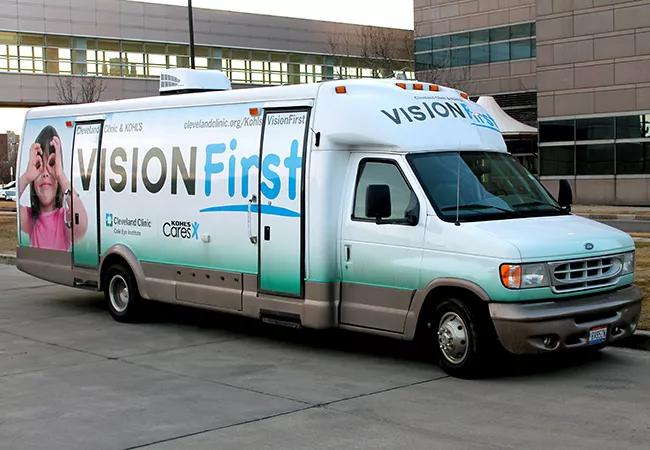Mobile unit offers free eye care for young children

While there is widespread support for pediatric vision screening to combat permanent vision impairment caused by amblyopia and strabismus, it does not always translate into action – especially among those with difficult access to care.
Advertisement
Cleveland Clinic is a non-profit academic medical center. Advertising on our site helps support our mission. We do not endorse non-Cleveland Clinic products or services. Policy

In Cleveland, Ohio, where 35 percent of the population lives below the poverty line, Cleveland Clinic doctors provide a van-based screening and treatment model, successfully taking the clinic to the patients. The program is proving to be both medically and cost effective in reaching young children in Cleveland’s underserved communities, performing 63,841 evaluations in a 12-year period, according to a recent retrospective review that was accepted for publication in the American Journal of Ophthalmology.
Data from the retrospective cohort study of the program was also presented in a poster titled “Vision First: A Comprehensive Screening Program for Young Children” by Joseph F. Griffith, MD, et al, at the American Association for Pediatric Ophthalmology and Strabismus 2015 annual meeting in New Orleans.
Amblyopia is the leading cause of monocular vision loss in Americans between the ages of 20 and 70, and is associated with lower rates of college graduation and worse psychological functioning. Strabismus is similarly associated with adverse effects related to interpersonal relationships, work and education, according to the manuscript on Vision First.
Many medical associations, including the American Academy of Ophthalmology, American Academy of Pediatric Ophthalmology and Strabismus, and American Academy of Pediatrics, support pediatric vision screening, but many children, especially those with poor access to medical care, are not screened.
Vision First was developed at Cleveland Clinic’s Cole Eye Institute in partnership with the Cleveland Metropolitan School District to provide free vision screening and treatment for children in the amblyogenic age group who are enrolled in public schools.
Advertisement
It was conceived as an integrated model to enable eye care professionals to screen, evaluate and treat eye diseases in children attending pre-kindergarten, kindergarten and first grade. Initial funding was obtained through private foundations and Cleveland Clinic. The program was later funded by the Cleveland Browns Foundation, and most recently by the Kohl’s Cares Foundation.
The program was designed to address the typical challenges of screening programs, such as limitations of current automated screening technologies and low rates of follow-up of those who fail by eye care professionals.
All evaluations take place inside a customized recreational vehicle, which has two vision examination lanes. The van parks in the school parking lot or near the school entrance. An optometrist and an ophthalmic technician conduct evaluations. The latter also serves as program coordinator, scheduler and van driver.
Initial screening includes testing of monocular near and distance visual acuity, stereoacuity, ocular alignment, motility, pupils and external abnormalities. Children meeting the 2003 American Academy of Pediatrics vision screening referral criteria undergo cycloplegic retinoscopy and indirect ophthalmoscopy of the optic nerve and posterior pole by the on-site optometrist. Children requiring further care are then referred to a pediatric ophthalmologist for follow-up care.
In the program’s first five years, vouchers were provided for a free pair of spectacles, but many expired unused.
Advertisement
Since the 2007-2008 academic year, children with refractive errors choose a spectacle frame from up to 60 options before leaving the van. They receive a free pair of glasses delivered directly to the school. The program coordinator orders the glasses and a local optician visits each school to adjust the fit for each child. The glasses are then given to parents.
The study’s main outcome measures were determination of the proportion of children with refractive errors, amblyopia and/or strabismus.
Between 2002 and 2014, the program performed 63,841 evaluations, representing approximately 55 percent of eligible children. The mean age of children evaluated was 6.27 years.
The study found:
These findings were consistent with three major NIH-sponsored studies: the Baltimore Pediatric Eye Disease Study, the Multi-ethnic Pediatric Eye Disease Study, and the Vision in Preschoolers Study.
Vision First found no statistically significant change in the prevalence of strabismus (1.73-2.24 percent, p=0.91) or amblyopia (0.9-2.08 percent, p=0.13) among first-grade students over the 12-year period.
The initial cost of the Vision First mobile van was $100,000 in 2002, including all ophthalmology equipment. The cost per child screened was approximately $26. The cost per pair of glasses dispensed was $33.
Advertisement
Advertisement

Early data shows risk is 73% higher in patients with lupus, 40% higher in patients with rheumatoid arthritis

Identifies weak spots in the cornea before shape change occurs

Study highlights the value of quantitative ultra-widefield angiography

Switching medications may decrease treatment burden and macular fluid

Interventions abound for active and stable phases of TED

Corneal imaging and interpretation play a major role

Cole Eye Institute imaging specialists are equal parts technician, artist and diagnostician

Effect of low-dose atropine and dual-focus contact lenses is unknown in patients with comorbid eye conditions